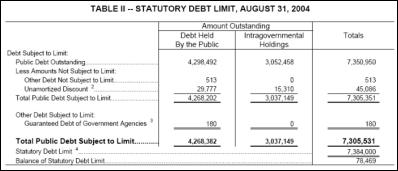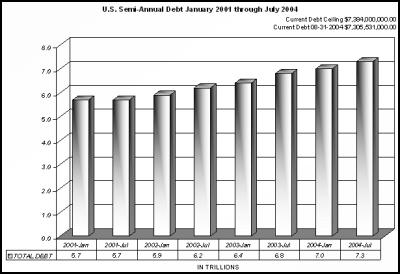Patricia Johnson: Bush Blows US Federal Overdraft
Bush Blows The US Federal Overdraft
By Patricia Johnson
At the close of business on Friday, January 19, 2001, the Public Debt of the United States of America was recorded at $5.7 trillion dollars. http://www.publicdebt.treas.gov and the total public debt subject to limitations was $5.95 trillion.
On Saturday, January 20, 2001, George W. Bush became the 43rd President of the United States and under his watch the public debt of the United States has skyrocketed to its current level of $7.3 trillion as of August 31, 2004.

(in millions)
Click for big version
The current statutory limit on the public debt imposed by Congress is $7.384 trillion per Public Law 108-24, passed May 27, 2003. The Congressional Budget Office (http://www.cbo.gov/showdoc.cfm?index=5773&sequence=2) estimates the current debt ceiling of $7.384 trillion will be reached during October of 2004, just a few weeks before the election.
A review of semi-annual debt indicates it has remained on a continual upward path since the Bush administration has been in office.

Click for big version
Under normal circumstances Congress could increase the debt ceiling, but the conditions we’re currently operating under are far from the norm.
(1) The debt ceiling has been raised again and again under George Bush, yet no matter how much it’s raised – it’s never quite enough for a president that appears to spend money like a drunken sailor.(2) 2004 is an election year – how can Bush convince the public that his economic policies are working when he can’t stay within the current debt ceiling?
How does this administration avoid getting a Congressional bailout prior to the election?
The CBO claims Treasury will take the following ‘temporary financing measures’ including: “ceasing to issue certain securities held in the Thrift Savings Plan (a retirement savings and investment plan for federal employees), suspending investments in the Civil Service Retirement Fund, and exchanging Treasury securities with the Federal Financing Bank (a government entity that facilitates federal borrowing and whose securities are not subject to the debt limit). In the most recent debt-limit crises, such measures have permitted the Treasury to remain below the statutory limit for more than three months.”
So, it appears the creative accounting practices of the Treasury Department will save the day, and the debt ceiling may not have to be raised until after the election. The problem with ‘creative accounting’ is sometimes you don’t quite get the results you want.
On May 20, 2004 The General Accounting Office released report number GAO-04-526 “ Analysis of Actions Taken during the 2003 Debt Issuance Suspension Period”. The actual report is 63 pages long, but an excerpt follows indicating billions of dollars were lost in 2003 due to actions taken by the Treasury Department to stay under the debt limit. The entire report may be read at the following URL: (www.gao.gov/cgi-bin/getrpt?GAO-04-526)
What GAO Found:On February 20, 2003, Treasury determined that a debt issuance suspension period was in effect. A debt issuance suspension period is any period for which the Secretary of the Treasury has determined that obligations of the United States may not be issued without exceeding the debt ceiling. During this period, which lasted until May 27, 2003, the Secretary took actions related to the Government Securities Investment Fund of the Federal Employees’ Retirement System (the G- Fund), the Civil Service Retirement and Disability Fund (the Civil Service fund), and the Exchange Stabilization Fund (ESF) to avoid exceeding the debt ceiling. Also, during fiscal year 2003, the Secretary initiated several actions involving the Civil Service Fund, FFB, and the Treasury general fund that related to Treasury’s efforts to manage the amount of debt subject to the debt ceiling. The Secretary took other actions to avoid exceeding the debt ceiling, such as suspending the sales of State and Local Government Series Treasury obligations and recalling non-interest-bearing deposits held by commercial banks as compensation for banking services provided to Treasury.
The actions taken, which were consistent with legal authorities provided to the Secretary and related to the G-Fund, the Civil Service fund, and ESF, initially resulted in interest losses to the G-Fund and ESF and principal and interest losses to the Civil Service fund. When the debt ceiling was increased to $7.4 trillion on May 27, 2003, the Secretary fully invested the G-Fund’s investments and on May 28, 2003, fully restored the interest losses, as required by law. On June 30, 2003, the Secretary fully compensated the Civil Service fund for principal and interest losses, as required by law. The losses related to ESF could not be restored without special legislation. As a result, related ESF losses of $3.6 million were not restored.
The actions initiated by Treasury in fiscal year 2003 that involved the early redemption of FFB debt obligations held by the Civil Service fund and exchanges of obligations among the Civil Service fund, FFB, and the Treasury general fund resulted in all three parties realizing gains or incurring losses. In some cases, GAO has been able to quantify the gains or losses that occurred as a result of these transactions. For example, according to FFB estimates, the Civil Service fund lost more than $1 billion in interest because of FFB’s redemption of FFB obligations held by the Civil Service fund before their maturity date and unforeseen interest rate changes. In other cases, however, information needed to understand the potential consequences of these actions will not be available for a number of years. The Secretary currently lacks the statutory authority to restore such losses and has not developed documented policies and procedures that can be used to minimize such losses in future actions that may be taken by Treasury that involve FFB and an account with investment authority such as the Civil Service fund.
GAO recommends that the Secretary of the Treasury (1) seek statutory authority to restore Civil Service fund losses associated with the October 2002 early redemption of Federal Financing Bank (FFB) obligations and (2) direct the Under Secretary for Domestic Finance to document necessary policies and procedures for exchange transactions between FFB and a federal government account with investment authority and seek any statutory authority necessary to implement the policies and procedures. Treasury agreed with our recommendations and has already taken certain steps to document the policies and procedures.”
George Bush promised to bring honor and integrity into the Whitehouse. Using creative accounting to extend the amount of time it takes to reach the debt ceiling may be a smart move politically, but it certainly cannot be considered honorable, especially when actions taken result in billions of dollars in losses.
Unfortunately, not everyone understands the long term consequences of increasing the debt ceiling. When the federal government collects less in taxes than it spends each year on programs, it’s called “deficit spending”, and the government has to borrow money to pay the difference. The government borrows money by selling Treasury bonds to both financial institutions and individuals. Over a period of time the Treasury bonds are paid off, with interest to the buyers.
The National Debt is then the total of the money borrowed to cover deficits, plus the interest owed.
During the first three years that President Bush has been in office, interest alone on the national debt has totaled more than a trillion dollars, with another $309 billion paid in interest during the first 11 months of 2004 (http://www.publicdebt.treas.gov/opd/opdint.htm)
The $1.3 trillion dollars paid in interest during the Bush years would pay for a lot of programs in this country.
©2004 Patricia Johnson
Patricia Johnson is a freelance writer and CEO of Articles and Answers. Visit us online at www.ArticlesandAnswers.com


 Eugene Doyle: The Fall Of Saigon 1975 - Fifty Years Of Repeating What Was Forgotten
Eugene Doyle: The Fall Of Saigon 1975 - Fifty Years Of Repeating What Was Forgotten Peter Dunne: Dunne's Weekly - Trump's Tariffs Still Pose Risks For New Zealand
Peter Dunne: Dunne's Weekly - Trump's Tariffs Still Pose Risks For New Zealand Keith Rankin: Barbecued Hamburgers And Churchill's Bestie
Keith Rankin: Barbecued Hamburgers And Churchill's Bestie Gordon Campbell: On Why The US Stands To Lose The Tariff Wars
Gordon Campbell: On Why The US Stands To Lose The Tariff Wars Eugene Doyle: Before It’s Too Late - Reimagine New Zealand’s Military Future
Eugene Doyle: Before It’s Too Late - Reimagine New Zealand’s Military Future  Binoy Kampmark: Gender Stunts In Space - Blue Origin’s Female Celebrity Envoys
Binoy Kampmark: Gender Stunts In Space - Blue Origin’s Female Celebrity Envoys